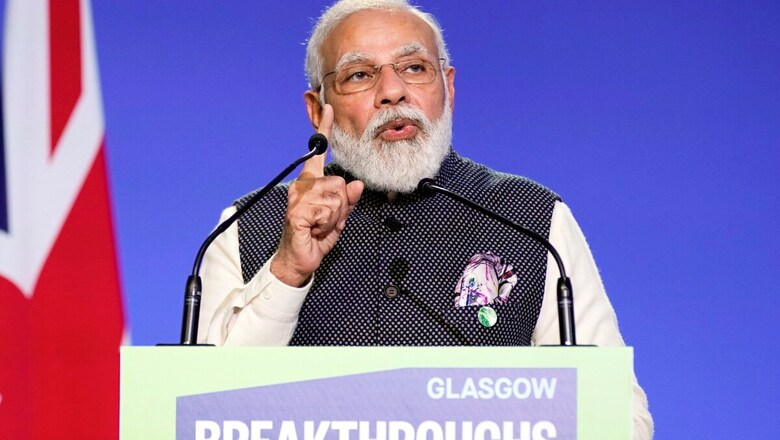
views
Climate change is an existential crisis for humanity. It is a clear and present danger. Wake-up call is there in front of our eyes on a daily basis but mostly we are either blind or deaf to this self-imposed assured destruction at an unprecedented rate. And this is a reality. There have been agreements and accords like the Paris Agreement and COPs, the 28th edition of which is going to be held in the UAE soon. Talks and more talks are witnessed at the international fora with ever louder voices, but mere voices they are which is quite visible in the lack of real outcomes, where hypocrisy and double speak are the buzzwords. Climate forums are unable to yield the desired results since the structural issues and the gaps are not genuinely addressed. Targets remain moving and the leaders keep chasing the revolving doors.
But there are still some exceptions to the rule and India is one of them. During its G20 presidency, fighting against climate change remains a priority as Prime Minister Narendra Modi speaks of ‘Vasudhaiva Kutumbakam’ — One World, one Family and One future’. He also worked for ‘One Earth One Grid. ‘There is no Plan or Planet B at least not for now. India’s plans for a World Solar Bank that will mobilise $1 trillion of investments in solar projects over the coming decade has been widely appreciated. Likewise, at the Climate action Summit in 2019, India and Sweden launched the Leadership Group for Industry Transition.
Antonio Guterres, UN Secretary General, during his visit to India had profusely complimented India for the steps being taken domestically and internationally to alleviate, adapt and mitigate the impact of climate change. India has been on the forefront of the quest for right energy mix with increasing share and focus of the renewal and clean energy and sustainable future. Guterres elucidated, “I am inspired by the Indian government’s decision to raise its target of renewable energy capacity from the initial 2015 goal of 175 gigawatts to 500 gigawatts by 2030. I have no doubt this decision will attract more and more international investors, such as the sovereign wealth funds and pension funds like the Caisse de dépôt et placement du Québec or the Abu Dhabi Investment Authority.”
India is on the verge of completing and even surprising the world by advancing goals due to the sheer sincerity and commitment and to set an example since India shows by example while standing up for the developing world for whom concessional green finance, green technologies and ‘spatial and differential treatment’ can make a significant difference.
Facts speak for themselves. A recent Reuters report confirms that India has managed to cut its greenhouse emissions rate faster-than-expected — 33% in the past 14 years. India’s average rate of reduction in emissions increased to 3% annually in the period 2016-19, from just about 1.5% in the period 2014-16. Prime Minister Modi at the 2020 Glasgow Summit committed India to achieve carbon neutrality latest by 2070. Given the pace of a concerted campaign and participation of people with ‘Sabka Saath, Sabka Vikas and Sabka Vishwas’, India hopes to advance its goals. No wonder PM Modi had rightly claimed, in June, that it is increasingly looking like India would be one of the few G20 countries to meet climate targets.
To do this India has focused on nearly all carbonising vectors and sectors. In renewables an unprecedented growth for the energy mix has been achieved — be it in the solar power that has become the cheapest in the world, hydro power, nuclear power or for that matter the tidal and the wind power. With France PM Modi had launched the International Solar Alliance which has become a resounding success in the area of renewables globally through investments and capacity building assistance. India’s National Hydrogen Mission and expanding international partnerships from Africa and West Asia to Europe and Scandinavia tell their own story.
Over the years, India has emerged as a part of the solution and not the problem as it diversifies its energy resources through green practices and technology across sectors. Since the transport sector is one of the major polluters, New Delhi aims to switch at least 30% vehicles to electric vehicles by 2030. Likewise, the country has expanded its targets of blending ethanol with standard fuel after completing the 10% blending target way before time. Similarly after achieving its voluntary target of reducing the carbon emissions intensity of GDP by 21% from in 2020 over that of 2005, India has undertaken to reduce the emissions intensity of GDP — the volume of carbon emissions emitted for every unit of GDP — by around 35% by 2030 over the 2005 levels. Not only that, India has nearly achieved its target of reducing fossil fuel usage for power generation by 40% with non-fossil fuels almost seven years ahead of schedule.
Even at the household levels, the Ujjwala scheme and clean cooking have led the way in reducing carbon intensity. It is also expanding its carbon sink capacity and incentivised carbon trading to expedite its goals. India’s strategic approach to establishing a bio-based economy, projected to reach $150 billion by 2025, bolstering the bio-manufacturing of low-carbon bio-based products, is underway, according to Minister Dr Jitender Singh. All this needs to be contextualised in the fact that for an energy-poor country like India, whose per capita energy use is one-third of the global average (680 kgoe against 1,800kgoe), it could be unrealistic to expect a virtual flattening of emissions during the initial years of the longer-term trajectory. But sincerity of the mission is evident by efforts being made by India.
All this is being done when, even though accused of being the third or fourth largest polluter by the Western outfits, forgetting that 1/6th of humanity has to be catered to with a viable developmental model, India pursues her sustainable economic development and economic growth consistently surpassing Western and other Asian economies in GDP terms. Despite the fact that India’s per capita emissions are half of that of the US and far below China’s and even a comparable nation like Brazil, let alone the US and Russia. But hypocrites and naysayers would easily overlook that.
India in any case is not looking at this as a pretext for argument to delay but an incentive to expedite achievement of the climate goals by setting an example for the developed and developing world which post pandemic and currency of the Russia-Ukraine war has slid into coal sink yet again sacrificing the avowed climate goals as well as SDGs. Reportedly the backlash in European countries against the ‘green’ policies of their governments have converted into a ‘greenlash’. On the other hand, India, despite numerous and gigantic challenges and quest for energy security and growth, goes ahead to positively contribute through her ideas, efforts and example for the global common good.
Indians traditionally know how to coexist with nature. No wonder, PM Modi gave the mantra of ‘LiFE – Life for Environment’ drawing from our ancient practices for a sustainable living. Mahatma Gandhi often lamented that there is enough for the needs of humanity in nature but not for their greed. We are all sitting on a time bomb. Hopefully, we shall not blow it faster.
Anil Trigunayat is the former Indian Ambassador to Jordan, Libya and Malta and currently Distinguished Fellow with Vivekananda International Foundation. Views expressed in the above piece are personal and solely that of the author. They do not necessarily reflect News18’s views.



















Comments
0 comment